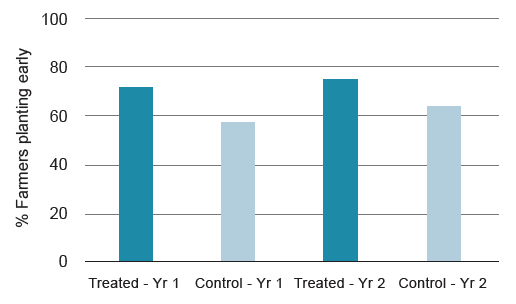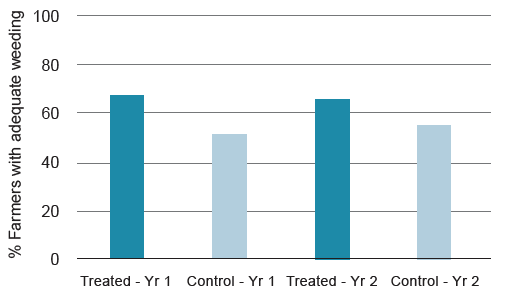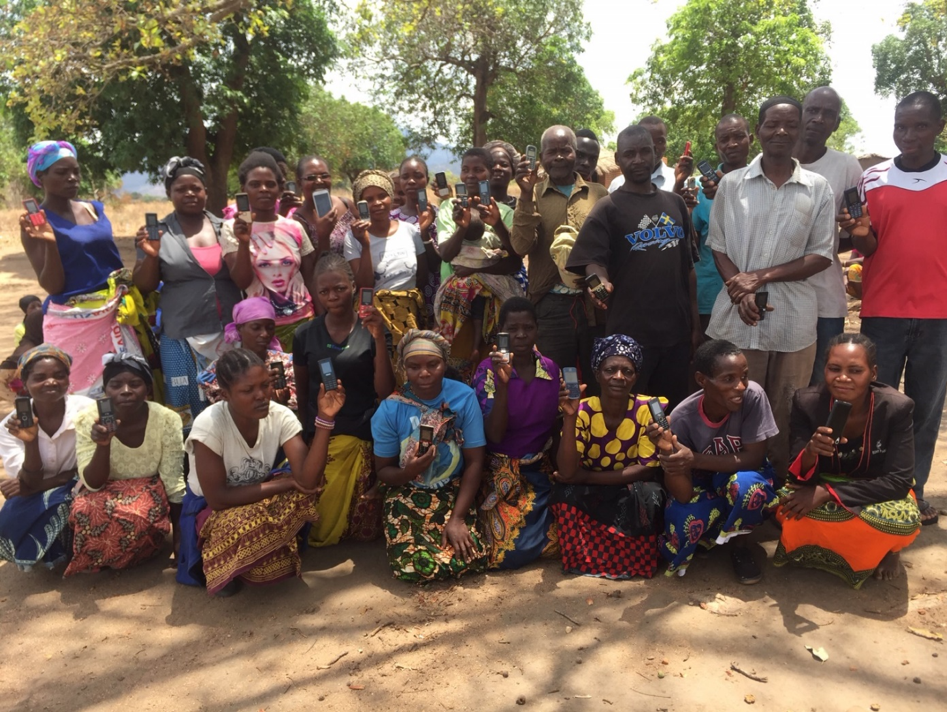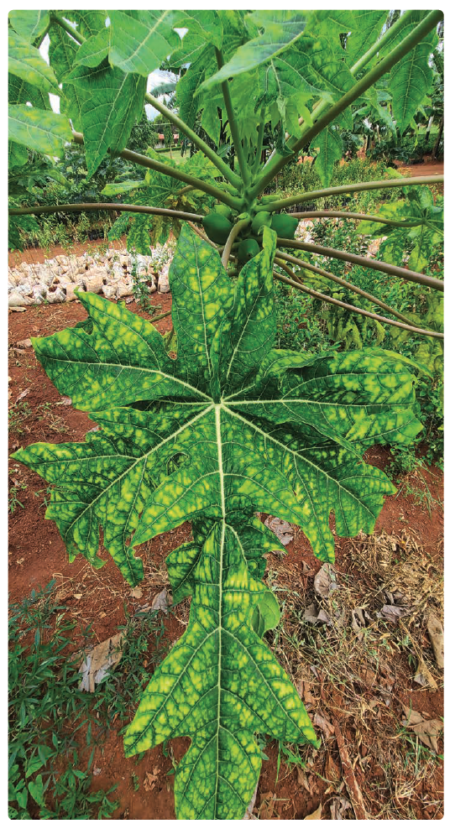By Regis Chikowo, Kennet Christensen, Brian King, and Sieg Snapp
The Malawi agricultural extension system is severely constrained and the existing extension network is grossly inadequate for effective information dissemination to farmers. The usefulness of Interactive Voice Response (IVR) technology to reach farmers with agronomic advisory was examined for two consecutive maize cropping seasons. This pilot work provides insight into the opportunities and pitfalls of employing IVR in agricultural technology dissemination.
An important precondition of agricultural development for livelihood improvement in Africa is securing the transition away from area expansion and towards productivity growth (Jayne and Sanchez, 2021). Higher agricultural productivity requires technical innovation that can encourage sustainable changes in farm practice. Greater and more efficient use of improved seed, mineral fertilizers, and organic inputs are widely recognized as preconditions for achieving productivity growth.
Over the past decade, the Malawi government has implemented a farm input subsidy program (FISP) to improve crop productivity by increasing farmers’ access to agricultural inputs (Jayne et al., 2018). While progress has been made, the full benefits of the intervention have not been realized due to poor crop and nutrient management practices amongst farmers. This is partly due to a weak and constrained agricultural extension system characterized by a very high farmer-to-extension staff ratio of 2500:1 (IFPRI, 2015). There are limited prospects for improvement of the government extension services due to funding and capacity limitations. To reduce this extension gap, a network of lead farmers has been put in place to provide complementary services. Regrettably, even this combined effort falls far too short for effectively disseminating technologies to farmers. A diversified and pluralistic national strategy to promote agricultural extension and communication for rural development is perceived as a promising solution.
Maize is the staple crop grown by every smallholder farmer in central and southern Malawi. However, maize yields have remained poor due to multiple factors that include poor soil fertility, poor seed varieties, low and inappropriate fertilizer management. At the root of some of these challenges is farmers’ lack of access to information and technologies due to an overstretched government extension system. While the Malawi government extension system has provided motorbikes to the extension workers to increase their mobility and reach more farmers, in practice, the motorbikes are rarely functioning, leaving the extension system grossly incapacitated. This is an untenable situation as most farmers rarely access agricultural extension services critical for adopting improved farming practices. Therefore, exploring alternative pathways for technology dissemination is essential for achieving Malawi’s desired food security outcome.
Mobile phone-based ICT (Information and Communications Technology) is well-rooted in the data-rich domains, such as banking, with simple communication platforms and applications that can be readily adapted to the agricultural sector (Aker, 2011). The dissemination of technologies through remote media is increasingly used to complement traditional agricultural extension pathways (e.g., Tinzaara et al., 2021; Thimnu, 2020; Tadesse and Bahiigwa, 2015). There is increasing use of mobile phones among rural farmers, providing room for interactive voice response (IVR) technology to support extension for agricultural transformation. To be of value, IVR used in other sectors should be adapted to the context of smallholder farming systems, particularly recognizing that a large proportion of farmers are illiterate. We hypothesize that access to targeted agronomy messages through IVR leads to better and timely decision-making on farms, contributing to increased resource use efficiencies and maize productivity. Therefore, the main objective of this study was to deliver timely and targeted messages on good maize agronomy to a trial group of smallholder farmers in central Malawi through IVR messaging and to evaluate the resultant changes in the implementation of effective agronomic practices that have a strong bearing on resources use efficiencies in maize production.
Introducing IVR to farmers and setting the scene
In November 2018, four focus group discussion (FGD) workshops were held with 35 farmers, each in the Machinga district in southern Malawi. The initial objective of the workshops was to introduce farmers to the public information access “321” services provided by Airtel Malawi. Farmers were also introduced the more targeted Via Mobile (VIAMO) platform with pointed IVR messages on maize agronomic practices. Other FGDs were held with a similar number of ‘control’ farmers for which discussions were limited to the broader Airtel 321 service.
During the FGDs, we encouraged farmers to provide narratives on how they manage their farms in general. Farmers were aware of the climatic and soil fertility limitations in their region. For example, farmers highlighted poor rainfall distribution as a key constraint. However, there were inconsistencies on interventions to improve productivity, with a minimal understanding of the water-nutrient interactions that are key in marginal agro-ecological conditions. Assessment of the main knowledge gaps was instrumental in formulating appropriate and relevant maize agronomy content for the IVR system.
IVR content development and packaging
The maize agronomy content for IVR messages was developed and packaged based on empirical data from trials (e.g., Snapp et al., 2018) and other publicly available extension material on maize agronomy in Malawi. After the content was developed, VIAMO recorded the IVR content in different formats and pre-tested with a group of farmers to evaluate the effectiveness of voices, tone, style formats for communicating agronomy information to farmers. The pre-testing phase revealed that the content presented in a conversation mode was more effective in improving farmers’ decisions on maize agronomy. We scheduled tailored agronomic advisory messages to be delivered timely during the maize production calendar.
For example, at the time of planting, the message on planting was phrased as follows: “Have you planted your maize seed yet?, press 1 for Yes and 2 for No.” Once the farmer indicated that they had planted, we proceeded to enquire if they had applied NPK fertilizer at the time of planting maize as a reminder for the need to apply NPK fertilizer at the next earliest opportunity.
Delivery of IVR messages
Between October 2018 and May 2019, the 140 trial farmers received IVR messages on key maize agronomic practices, beginning about three weeks from the expected onset of the cropping season until about maize physiological maturity. In contrast, the 140 farmers in the control group did not receive any maize agronomy messages other than the general messages from the Airtel 321 platform.
The best agronomic practices provided by IVR included: land preparation, planting density, fertilizer types and their application, and weeding. The program sent one message per week, repeated at least three times to each trial farmer, based on the cropping season calendar. For unreachable participants on the first attempt, calls were repeated at least three times per day.
In October 2019, we initiated a second cycle and increased the number of trial farmers to 650, including those initially engaged in October 2018. Thus, we created an exposure time as a factor: 1) 510 farmers newly engaged during the 2019/20 cropping season – the 1-year IVR cycle farmers, and 2) 140 farmers initially engaged during the 2018/2019 cropping season – the 2-year IVR cycle farmers. This research design enabled investigating the effect of IVR exposure time on adopting good maize agronomic practices.
After each of the two IVR campaign cycles, we conducted electronic evaluation surveys for both trial and control farmers, with follow-up questions on main agronomic practices implemented by farmers on maize plots. There were slight differences in the evaluation approach for these two groups. We explicitly referred to their experience with IVR calls on improved maize agronomy for the trial group. For the control farmers, we reminded them that they had agreed to take part in the study based on our early interactions and FGDs.
Key results from piloting IVR for scaling maize agronomy
During the 2018/19 cropping season, 72% of IVR treated farmers planted maize early (by November 30th) compared with 57% of the control farmers who had planted maize by this date. The 2019/2020 cropping season data was comparable to the first season (Fig. 1). This response is significant as the benefits of early planting for improved maize productivity are widely established (e.g., Nyagumbo et al., 2017). Following a long dry season, early planting with first rainfall harnesses the early mineral nitrogen (N) flush from soil organic matter otherwise missed when farmers plant late (Sachs et al., 2010). Soil organic matter mineralization is often a significant source of plant-available N for low external nutrient input cropping systems. Farmers are also able to optimize seasonal rainwater use with early planting.

The messages on the benefits of early planting were effective at improving farmers’ decision-making. The proportion of farmers who planted late, more than three weeks after the onset of rainfall during the 2018/19 cropping season (after December 10th), was only 5% among IVR trial farmers compared to 20% for the control group. This positive response was repeated during the 2019/2020 cropping season.
About 90% of the young farmers (< 21 years) planted their maize within one week of the onset of rains for the treated group compared to 72% for the control group. The message on early planting was included in both the IVR and Airtel 321 platforms. The result suggests that extension communication through the remote media platforms was of more benefit to young farmers.
Access to NPK basal fertilizer was not influenced by IVR treatment. Purchase of fertilizer is often planned and done several months ahead of the cropping season. It is not surprising that there was no significant influence of IVR on access to NP fertilizer in the short-term. Also, access to fertilizer is expected to be mainly influenced by the capacity of farmers to purchase fertilizer. Farmers who had access to NPK fertilizer generally applied the fertilizer within two weeks after germination for both the treated and control farmers groups.
The timing of applying side-dressing urea fertilizer, on the other hand, was influenced by targeted information provided through IVR: 49% of farmers in the treated group applied urea fertilizer, about a month after planting as recommended, compared to 25% for the control group. Therefore, IVR treated farmers used urea fertilizer more efficiently as a side-dress than farmers receiving the general 321 service only. In the future, IVR urea side-dress fertilizer recommendations could be tailored to obtaining local weather as part of response farming where more fertilizer is applied during wetter seasons and some fertilizer withheld in poor rainfall seasons.
A more significant proportion of farmers (67%) in the IVR treated group weeded twice, compared to 51% belonging to the control group during Year 1. During Year 2, 65% treated farmers weeded twice compared with 55% in the control group (Fig. 2). This 10% gap could translate to significant maize production differences when scaled up in the community. Two weeding events or more are recommended for maize production, and content on this subject delivered to the IVR treated group seemed to have influenced farmer behavior. However, we noted that the number of farmers who responded to this topic was low; therefore, in-person interviews could be vital to augment remotely obtained farmer feedback.

Participation time significantly impacted the maize seed varieties selected by farmers. About 71% of Cycle 2 farmers used hybrid maize seed compared with 40% for the Cycle 1 farmers. The influence of IVR communication on the increased use of hybrid seed varieties is expected to lever increased fertilizer use in the long-term. Hybrid maize varieties are generally more responsive to fertilizer application and incentivize farmers to invest in increased fertilizer use. More Cycle 2 farmers also planted maize earlier, and 80% applied NPK between planting and germination compared with 69% for the Cycle 1 farmers. While poor practices in the use of urea fertilizer, such as application too late, six weeks or later from crop emergence or surface placement as opposed to covering the fertilizer, were still prevalent on for both farmer groups, a notable improvement in urea management was observed for Cycle 2 farmers. Urea fertilizer is prone to loss through volatilization when farmers fail to cover the fertilizer with soil. It is important to apply urea fertilizer in time for the organic molecule to mineralize and become available for crop uptake.
Farmers’ feedback on the IVR delivery process
Further FGDs were held with both trial and control farmer groups during the post-IVR messaging phase, with 10-15 participants per session. Audio messages were disseminated to the control and treatment groups, followed by discussions on farmers’ comprehension and perception. An analytical process was used to assess farmers’ responses to the content and their behavior change. Participants indicated that the messages were relevant and informative.
I am now harvesting a lot of maize from a small plot. I have followed the advice for two seasons. I now use fertilizer appropriately. This is why I will have adequate maize this year from my farm.”
— Steven Williams from Mtubwi
Since farmers received maize agronomy advice ahead of the planting season they considered the messages to be timely and relevant for the maize cropping calender. Early planting was associated with healthier crops and less weed pressure as crops compared to late planted crops.
Farmers were satisfied with the dialogue messaging format and this is best expressed in the words of one of the farmers:
“When we first listened to the instructions, we thought they would be difficult to follow through, but they were not and this year it was even easier for us.”
—Daniel White, a 2-year Cycle farmer
Summary
We demonstrated that IVR messaging could support tailored messages that enable the adoption of improved agronomic practices for maize on smallholder farms. The management practices that were improved by IVR messaging included early maize planting, correct timing of urea top-dress fertilizer application, and effective weeding, at least twice during the growing season. Further improvement in our research approach to improve the quality of evaluation data include triangulation of survey responses through in-person interviews and measurements of maize yield through plot cuts to determine the yield benefits. Overall, focus group discussions revealed that participants were satisfied with the dialogue messaging format.
Dr. Chikowo is Assistant Professor with Michigan State University, e-mail: chikowor@msu.edu. Mr. Christensen is Country Director with VIAMO. Dr. King is Coordinator of the CGIAR Platform for Big Data in Agriculture with CIAT. Dr. Snapp is Professor of Soils and Cropping Systems Ecology with Michigan State University.
Acknowledgements
The Authors acknowledge financial support from P4G – Partnering for Green Growth and the Global Goals 2030. Additional funding which enabled the establishment of action research field learning labs was provided by the United States Agency for International Development (USAID) through the Africa Research in Sustainable Intensification for the Next Generation (Africa RISING) program as part of the US Government’s Feed the Future Initiative.
Cite this article
Chikowo, R., Christensen, K., King, B., Snapp, S. 2022. Enabling Adoption of Improved Agronomic Practices with ICT-based Farmer Advisory Services. Growing Africa 1(1), 33-36. https://doi.org/10.55693/ga11.cmzp5131
Reference
Aker, J.C. 2011. Dial A for agriculture: Using ICTs for agricultural extension in developing countries. Agric. Econ. 42(6). 631-647.
IFPRI. 2015. The national extension policy of malawi – lessons from implementation. Malawi Strategy Support Program (MaSSP) Policy Note 23.
Jayne, T.S., et al. 2018. Review: Taking stock of Africa’s second-generation agricultural input subsidy programs. Food Policy 75, 1-14.
Jayne, T.S., Sanchez, P.A. 2021. Agricultural productivity must Improve in Sub-Saharan Africa. Science 372, 1045-1047.
Nyagumbo, I. et al. 2017. Planting date and yield benefits from conservation agriculture practices across Southern Africa. Agric. Sys. 150. 21-33.
Sachs, W.J., et al. 2010. Crop planting dates: an analysis of global patterns. Glob. Ecol. Biogeogr. 19, 1-14.
Snapp, S.S., et al. 2018. Maize yield and profitability tradeoffs with social, human and environmental performance: Is sustainable intensification feasible? Agric. Sys. 162, 77-88.
Tadesse, G., Bahiigwa, G. 2015. Mobile Phones and Farmers’ Marketing Decisions in Ethiopia. World Devel. 68. 296-307.
Thimnu, J. 2020. Africa’s mobile agricultural revolution: farming apps in sub-Saharan Africa. Int. J. Agric. Ext. Rural Devel. Studies 7, 1-11.
Tinzaara, W., et al. 2021. Mobile phone technology for increasing banana productivity among smallholder farmers in Uganda. Int. J. Agric. Ext. Rural Devel. 13, 1-13.





